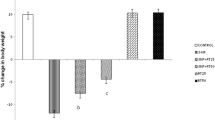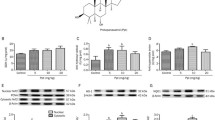Abstract
Huntington’s disease is a fatal neurodegenerative disorder, characterized by cognitive and motor dysfunction, abnormal energy metabolism, and mitochondrial dysfunction. 3 nitropropionic acid (3 NP) is a gold model used to induce Huntington’s disease in animals. Ficus religiosa is supposed to have effective neuroprotective role on oxidative stress and cognitive functions. The present study has been designed to demonstrate the neuroprotective role of ethyl acetate and ethanolic extract of Ficus religiosa leaves against 3 NP induced nerotoxicity in rats. Ethyl acetate and ethanolic extracts of Ficus religiosa were prepared by soxhaltion method and were administered (100, 200 and 400 mg/kg, p.o) for 14 days in 3 NP treated animals. 3 NP (30 mg/kg, i.p) was administered for 14 days systemically. Behavioral assessments were performed on 1st, 3rd, 7th, 10th and 14th day. Animals were sacrificed on 14th day for biochemical and histpathological estimation. This study indicated significant alteration in behavioral parameters (hypolocomotion, muscle incoordination and memory deficit), biochemical (increased lipid peroxidation, decreased catalase, superoxide dismutase and reduced glutathione), and increased neurochemical (increased acetylcholinesterase enzyme) in 3 NP treated animals. Higher dose of ethyl acetate and ethanolic extracts (400 mg/kg) of Ficus religiosa prevented behavioral, biochemical and neurochemical alterations compared to 3 NP treated rats. Lower doses (100 and 200 mg/kg) of both extracts per se did not show significant activity. The study thus proved that Ficus religiosa treatment protects the brain from oxidative stress and might be incorporated of this plant as prophylactic therapy for treatment of Huntington’s disease.




Similar content being viewed by others
References
Aebi H (1984) Catalase in vitro. Methods Enzymol 105:121–126
Aiyegoro OA, Okoh AI (2009) Use of bioactive plant products in combination with standard antibiotics: implications in antimicrobial chemotherapy. J Med Plant Res 3:1147–1152
Akhtar MS, Iqbal Z, Khan MN, Lateef M (2000) Anthelmintic activity of medicinal plants with particular reference to their use in animals in the indo-Pakistan subcontinent. Small Rumin Res 38:99–107
Beal MF, Brouillet E, Jenkins BG, Ferrante RJ, Kowall NW, Miller NW, Storey E, Srivastava R, Rosen BR, Hyman BT (1993) Neurochemical and histologic characterization of striatal excitotoxic lesions produced by the mitochondrial toxin 3- nitropropionic acid. J Neurosc 13:4181–4192
Benchoua A, Trioulier YI, Zala D, Gaillard MC, Lefort N, Dufour N, Saudou F, Elalouf JM, Hirsch E, Hantraye P, Déglon N, Brouillet E (2006) Involvement of mitochondrial complex II defects in neuronal death produced by N-terminus fragment of mutated huntingtin. Mol Biol Cell 17:1652–1663
Beyer WF, Fridovich I (1987) Assaying for superoxide dismutase activity: some large consequences of minor changes in conditions. Anal Biochem 161(2):559–566
Borlongan CV, Koutouzis TK, Randall TS, Freeman TB, Cahill DW, Sanberg PR (1995) Systemic 3- nitropropionic acid, behavioral deficits and striatal damage in adult rats. Brain Res Bull 36:549–556
Browne SE, Ferrante RJ, Beal MF (1999) Oxidative stress in Huntington's disease. Brain Pathol 9:147–163
Chakraborty J, Nthenge-Ngumbau DN, Rajamma U, Mohanakumar KP (2014) Melatonin protects against behavioural dysfunctions and dendritic spine damage in 3-nitropropionic acid-induced rat model of Huntington’s disease. Behav Brain Res 264:91–104
Cruz V, Santamaria A (2007) Integrative Hypothesis for Huntington’s disease: A Brief Review of Experimental Evidence Physiol Res 56:513–526
Devi WB, Sengottuvelan S, Haja SS, Lalitha V, Sivakumar T (2011) Memory enhancing activities of Ficus religiosa leaves in rodents. Int J Res Ayurveda Pharm 2(3):834–838
Ellman GL, Courtney KD, Andres V, Featherstone RM (1961) A new and rapid colorimetric determination of acetylcholinesterase activity. Biochem Pharmacol 7:88–95
Ghani A (1998) Medicinal plants of Bangladesh with chemical constituents and uses. Asiatic Society of Bangladesh, Dhaka, p. 236
Hanna DM, Tadros MG, Khalifa AE (2015) ADIOL protects against 3-NP-induced neurotoxicity in rats: possible impact of its anti-oxidant, anti-inflammatory and anti-apoptotic actions. Prog Neuro-Psychopharmacol Biol Psychiatry 60:36–51
Harborne JB (1998) Phytochemical methods, 3rd edn. Chapman and Hall, London, p. 26
Hogg SA (1996) Review of the validity and variability of the elevated plus-maze as an animal model of anxiety. Pharmacol Biochem Behav 54:21–30
Khan A, Jamwal S, Bijjem KR, Prakash A, Kumar P (2015) Neuroprotective effect of hemeoxygenase-1/glycogen synthase kinase-3β modulators in 3-nitropropionic acid-induced neurotoxicity in rats. Neuroscience 287:66–77
Kim GW, Copin JC, Kawase M, Chen SF, Sato S, Gobbel GT, Chan PH (2000) Excitotoxicity is required for induction of oxidative stress and apoptosis in mouse striatum by the mitochondrial toxin, 3-nitropropionic acid. J Cereb Blood Flow Metab 20(1):119–129
Kumar P, Kalonia H, Kumar A (2010) Huntington’s disease: pathogenesis to animal models. Pharmacol Rep 62(1):1–14
Kumar P, Kumar P, Khan A, Deshmukh R, Sharma PL (2014) Role of neurosteroids in experimental 3-nitropropionic acid induced neurotoxicity in rats. Eur J Pharmacol 723:38–45
Malhotra CL, Das PK, Dhalla NS (1960) Parasympatholytic activity of Ficus religiosa Linn. Indian J Med Res 48:734–742
McGeer PL, McGeer EG, Fibiger HC (1973) Choline acetylase and glutamic acid decarboxylase in Huntington’s chorea. A preliminary study. Neurology 23(9):912–917
Monk LS, Fagerstedt KV, Crawford RM (1989) Oxygen toxicity and superoxide dismutase as an antioxidant in physiological stress. Physiol Plant 76:456–459
Nakamura S, Takahashi T, Yamashita H, Kawakami H (2001) Nicotinic acetylcholine receptors and neurodegenerative disease. Alcohol 24:79–81
Nakao N, Grasbon-Frodi EM, Widner H, Brundin P (1996) Antioxidant treatment protects striatal neurons against excitotoxic insults. Neuroscience 73:185–200
Nam E, Lee SM, Koh SE, Joo WS, Maeng S, Im HI, Kim YS (2005) Melatonin protects against neuronal damage induced by 3-nitropropionic acid in rat striatum. Brain Res 1046:90–96
Ohkawa H (1979) Assay for lipid peroxides in animal tissues by thiobarbituric acid reaction. Anal Biochem 95(2):351–358
Panda SK, Panda NC, Sahue BK (1976) Phytochemistry and pharmacological properties of Ficus religiosa: an overview. Indian Vet J 60:660–664
Pandit R, Phadke A, Jagtap A (2010) Antidiabetic effect of Ficus religiosa extract in streptozotocin-induced diabetic rats. J Ethnopharmacol 128:462–466
Patil MS, Patil CR, Patil SW, Jadhav RB (2011) Anticonvulsant activity of aqueous root extract of Ficus religiosa. J Ethanopharmacol 133:92–96
Pellow S, File SE (1986) Anxiolytic and anxiogenic drug effects on exploratory activity in an elevated plus-maze: a novel test of anxiety in the rat. Pharmacol Biochem Behav 24:525–529
Prasad PV, Subhaktha PK, Narayana A, Rao MM (2006) Medico-historical study of "aśvattha" (sacred fig tree), bull. Indian Institute of History of Medicine (Hyderabad) 36:1–20
Rahman S, Zhang J, Corrigal WA (2003) Effects of acute and chronic nicotine on somatodendritic dopamine release of the rat ventral tegmental area: in vivo microdialysis study. Neurosci Lett 348:61–64
RajaSankar S, Manivasagam T, Sankar V, Prakash S, Muthusamy R, Krishnamurti A, Surendran S (2009) Withania somnifera Root extract improves catecholamines and physiological abnormalities seen in a Parkinson’s disease model mouse. J Ethnopharmacol 125:369–373
Ramaswamy S, McBride JL, Kordower JH (2007) Animal models of Huntington’s disease. ILAR J 48(4):356–373
Ravichandran V, Suresh B, Sathishkumar MN, Elango K, Srinivasan R (2007) Antifertility activity of hydroalcoholic extract of Ailanthus excels (Roxb): an ehanomedicines used by tribals of Nilfiris region in Tamilnadu. J Ethnopharmacol 112:189
Reddy DS, Kulkarni SK (1998) Possible role of nitric oxide in the nootropic and anti amnesic effects of neurosteroids on aging and dizocilpine induced learning impairment. Brain Res 799(2):215–219
Rodgers RJ, Johnson NJT (1998) Behaviorally selective effects of neuroactive steroids on plus-maze anxiety in mice. Pharmacol Biochem Behav 59:221–232
Roos RAC (2010) Huntington’s disease: a clinical review. Orphanet J Rare Dis 5:40
Saha S, Goswami G (2010) Study of anti ulcer activity of Ficus religiosa L. On experimentally induced gastric ulcers in rats. Asian Pac J Trop Med 3(10):791–793
Schulz JB, Matthews RT, Henshaw DR, Beal MF (1999) Neuroprotective strategies for treatment of lesions produced by mitochondrial toxins: implications for neurodegenerative diseases. Neuroscience 71:1043–1048
Seaman RL (2000) Effects of acute systemic 3- nitropropionic acid administration on rat activity and acoustic startle. Neurosci Lett 280:183–186
Singh D, Goel RK (2009) Anticonvulsant effect of Ficus religiosa: role of serotonergic pathways. J Ethnopharmacol 123(2):330–334
Sirisha N, Sreenivasulu M, Sangeeta K, Chetty CM (2010) Antioxidant properties of Ficus species-a review. Int J PharmTech Res 3:2174–2182
Srivastava SK, Beutler E (1968) Accurate measurement of oxidized glutathione content of human, rabbit, and rat red blood cells and tissues. Anal Biochem 25(1):70–76
Túnez I, Tasset I, Pérez-De La Cruz V, Santamaría A (2010) 3-nitropropionic acid as a tool to study the mechanisms involved in Huntington’s disease: past, present and future. Molecules 15(2):878–916
Uma B, Prabhakar K, Rajendran S (2009) In vitro antimicrobial activity and phytochemical analysis of Ficus religiosa L. And Ficus benghalensis L. Against Diarrhoeal Enterotoxigenic E. coli. Ethnobotanical Leaflets 13:472–474
Vauzour D, Mateos AR, Corona G, Oruna-Concha MG, Spencer JPE (2010) Polyphenols and human health: prevention of disease and mechanisms of action. Nutrients 2:1106–1131
Verma RS, Bhatia KS (1986) Chromatographic study of amino acids of the leaf protein concentrates of Ficus religiosa Linn and Mimusops elengi Linn. Indian Journal of Pharmacy Practice 23:231–232
Acknowledgments
We are thankful to Institute of Pharmacy, Nirma University, Ahmedabad, Gujarat, India for providing laboratory facilities.
Author information
Authors and Affiliations
Corresponding author
Ethics declarations
Ethical statement
The experimental protocols were approved by the Institutional Animal Ethics Committee, Institute of Pharmacy, Nirma University, Ahmedabad, Gujarat, India.
Conflict of Interest
The authors declare that there is no conflict of interests regarding the publication of this paper.
Rights and permissions
About this article
Cite this article
Bhangale, J.O., Acharya, N.S. & Acharya, S.R. Protective effect of Ficus religiosa (L.) against 3-nitropropionic acid induced Huntington disease. Orient Pharm Exp Med 16, 165–174 (2016). https://doi.org/10.1007/s13596-016-0237-7
Received:
Accepted:
Published:
Issue Date:
DOI: https://doi.org/10.1007/s13596-016-0237-7




